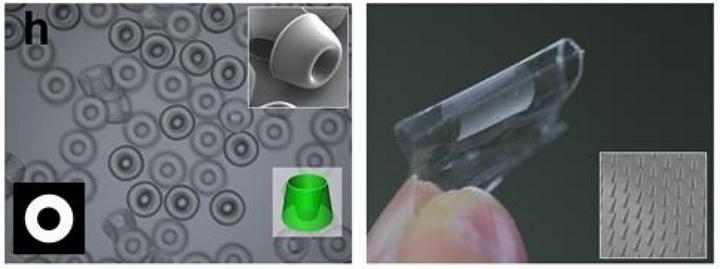 Diffusion describes the fact that molecules, vibrating with random motion in a gas or liquid, move toward a state of equilibrium where those molecular species in a mixture are uniformly dispersed until the concentration of any one species becomes the same throughout the medium. It’s a sort of Fick’s second law issue, and Fick’s laws have been used to model transport processes in foods, neurons, biopolymers, pharmaceuticals, porous soils, and nuclear materials.
Diffusion describes the fact that molecules, vibrating with random motion in a gas or liquid, move toward a state of equilibrium where those molecular species in a mixture are uniformly dispersed until the concentration of any one species becomes the same throughout the medium. It’s a sort of Fick’s second law issue, and Fick’s laws have been used to model transport processes in foods, neurons, biopolymers, pharmaceuticals, porous soils, and nuclear materials.
It’s an understanding of that law that has led Professor Shin-Hyun Kim and a team of researchers working at the Department of Chemical and Biomolecular Engineering within the Korea Advanced Institute of Science and Technology (KAIST) to develop a novel, photolithographic technology that uses oxygen diffusion to control the creation of functional, 3D micropattern shapes.
Photolithography is an optical process for transferring micropatterns to various substrates by exposing specific regions of what’s called the “photoresist” layer to an ultraviolet light source. Industries that require such micropatterns, such as semiconductor manufacture, relied on photomasks.
These photomasks protect specific regions of the substrate from the input UV light, and locations covered by the photomask remain intact as areas exposed to the UV light are washed away. Until now, this technology was limited to fabricating two-dimensional, disc-shaped designs. The problem with creating any other types of shapes occurs because the boundaries between the exposed and covered regions are in a parallel arrangement with the direction of the UV light.
What Kim’s team discovered is a two-fold observation: areas exposed to UV light lowered the concentration of oxygen in that area, and manipulation of the diffusion speed and direction allowed control of the formation, shape, and size of the polymers.
This observation led them to a new photolithographic technology which enabled the production of micropatterns–with three-dimensional structures–in various shapes and sizes.
 Kim says that as oxygen was considered an inhibitor during photopolymerization, photoresist under UV light creates radicals which initialize a chemical reaction. He and his team eliminated these radicals by introducing the presence of oxygen to prevent the reaction.
Kim says that as oxygen was considered an inhibitor during photopolymerization, photoresist under UV light creates radicals which initialize a chemical reaction. He and his team eliminated these radicals by introducing the presence of oxygen to prevent the reaction.
According to Kim, he and his team exploited the presence of oxygen as they found that while the region affected by the UV light lowered oxygen concentration, the concentration in the untouched regions remained unchanged. When the speed of the oxygen flow is slow, the diffusion occurs in parallel with the direction of the UV light. When it’s sped up, the diffusion process develops horizontally and outward from the area affected by the UV light.
Kim and his team proved this phenomenon both empirically and theoretically, and by injecting an external oxygen source, the team found they could manipulate diffusion strength and direction to control the shape and size of the polymers within.
By using these polymerization inhibitors, they found it was possible to create complex, three-dimensional micropatterns.
“While 3D printing is considered an innovative manufacturing technology, it cannot be used for mass-production of microscopic products,” says Professor Kim. “The new photolithographic technology will have a broad impact on both the academia and industry especially because existing, conventional photolithographic equipment can be used for the development of more complex micropatterns.”
Kim says the research was dedicated to the late Professor Seung-Man Yang of the Department of Chemical and Biomolecular Engineering at KAIST. Professor Yang was considered one of the great scholars in Korea within the field of hydrodynamics and colloids.
Can this new photopolymerization process be considered 3D printing? Let us know your thoughts in the Oxygen Diffusion Technique forum thread on 3DPB.com.
Subscribe to Our Email Newsletter
Stay up-to-date on all the latest news from the 3D printing industry and receive information and offers from third party vendors.
You May Also Like
Printing Money Episode 17: Recent 3D Printing Deals, with Alex Kingsbury
Printing Money is back with Episode 17! Our host, NewCap Partners‘ Danny Piper, is joined by Alex Kingsbury for this episode, so you can prepare yourself for smart coverage laced...
Insights from Cantor Fitzgerald on AM’s Q1 2024 Landscape
A recent survey by Cantor Fitzgerald sheds light on the persistent challenges within the additive manufacturing (AM) industry in the first quarter of 2024. Based on responses from 38 industry...
3D Printing Financials: Xometry’s Scaling up and Strong Start to 2024
Xometry (Nasdaq: XMTR) kicked off 2024 with strong results, boosting its marketplace and technology to new heights. Both revenue and gross margin soared, fueled by an expanding global network of...
3D Printing Financials: Desktop Metal Targets Recovery Amid Net Losses and Revenue Downturn
Despite facing a decline in revenue and the persistent challenges of a tight economic climate, Desktop Metal (NYSE: DM) is making strides toward operational efficiency. The first quarter of 2024...


































